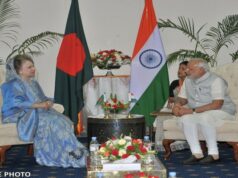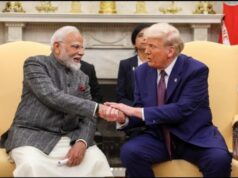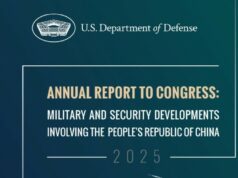NEW DELHI: Why is the U.S. Senate working on a bipartisan non-binding resolution recognising Arunachal Pradesh as part of India? The U.S. government has, for the last 60 years, held that Arunachal is part of India.
Arun Singh, former ambassador to the U.S., (2015-16) believes that the “the draft resolution is a political message,” which reflects a “consolidation” in the U.S. Congress of the U.S.-India relationship and mutual concerns over China’s aggressive and assertive postures, as well as the growing influence of the Indian-American diaspora.
“It is a reiteration of the American position since the conflict of 1962, and I have a reference to this in my book on how the US embassy in Delhi managed to persuade the White House then to support India’s position,” says Nirupama Rao, former foreign secretary (August 2009–July 2011) who also served as India’s ambassador to the U.S. (August 2011–November 2013) and China (November 2006–July 2009).
But “this one is a sign of the very significant improvement in India-U.S. relations since then, and that we are now strategic partners doing more and more together when it comes to the situation in the Indo-Pacific,” she adds. “Both nations have their challenges and problems with our China relationship… so I assume the Chinese are not going to be amused to say the very least.”
———————————————————————————————————————————————————————-
Read More:
More reports and videos on Arunachal
———————————————————————————————————————————————————————-
“This brings both U.S. parties together on an issue of strategic importance and points to a bipartisan consensus on relations with India, and (indicates) the future of this relationship is secure in terms of the cooperation that we are obviously going to build further,” Menon argues.
The resolution “reaffirming the state of Arunachal Pradesh as Indian territory and condemning the People’s Republic of China’s provocations in South Asia” was introduced in the U.S. Senate Foreign Relations Committee on February 16 by Senator Jeff Markley (Democrat, Oregon) and endorsed by Bill Haggerty (Republican, Tennessee) and John Cornyn, (Republican, Texas).
Senators Markley and Haggerty are influential members of the Senate Foreign Relations Committee (SFRC), while Cornyn, a former member of the Senate Select Committee on Intelligence, is the co-founder of the Senate India Caucus. The resolution now has to be debated and passed by the full Senate before it is formally considered as an expression of the Senate’s sentiment.
It lists various transgressions and provocations by China along the LAC. These include the “use of military force to change the status quo along the Line of Actual Control, as well as additional provocations including the construction of villages in contested areas, expansion of territorial claims in Bhutan, and publication of maps assigning Mandarin-language names to cities and features in the Indian state of Arunachal Pradesh.”
The resolution then commends and applauds India for taking steps to defend itself against aggression and security threats from the People’s Republic of China, “including through securing its telecommunications infrastructure, examining its procurement processes and supply chains, implementing investment screening standards, and expanding its cooperation with Taiwan in public health and other sectors,” as well as “increasing its development efforts in Arunachal Pradesh, including for improving border infrastructure, connectivity, and energy security, including renewable energy production.”
Significantly, the resolution also supports “as part of a joint vision for a free and open Indo-Pacific, India’s continued defence modernization, including its diversification away from countries that fail to respect the sovereignty and territorial integrity of other nations.”
This, according to a senior Indian diplomat, is “obviously meant to placate senators who are concerned about India’s decision to continue buying Russian weapons and systems like S-400 in defiance of U.S. sanctions.”
The resolution also “encourages like-minded international partners and donors to likewise bolster their assistance efforts to Arunachal Pradesh,” and commits “to deepening United States assistance to the region, including through the Department of State and the United States Agency for International Development using funding mechanisms such as the Countering PRC Influence Fund.”
———————————————————————————————————————————————————————-
Read More:
Full text of draft resolution on Arunachal
———————————————————————————————————————————————————————-
“The unequivocal assertion that Arunachal is not a ‘disputed region’ as claimed by the Chinese might also encourage nations and multilateral institutions that have hesitated to fund projects in the state to reconsider, although of course the final decision on whether to accept such funding would rest with the Indian government,” says Arun Singh.
The resolution also “supports further strengthening the United States-India bilateral partnership, including through enhanced defense interoperability and information-sharing especially for early warning systems, the United States-India Initiative on Critical and Emerging Technology, further economic cooperation, and our broad and long-standing people-to-people ties.”
Rao believes that this resolution “…needs to be seen in the larger context, not just the U.S. position on Arunachal Pradesh… It also brings what is happening on the continental or land border side into a parallel sort of focus with the whole Indian Ocean/Indo-Pacific maritime environment that we deal with today, in a sense erasing the lines between the two, and treat it in one context: what happens on land and what happens on sea—and they both point to a very aggressive, revanchist China, which democratic countries such as ours are confronting today, and that we have to cooperate in order to deal with challenge.”
More importantly, she concludes, “this reflects the growing weight, the importance, the substance of the Indo-U.S. relationship.”
In a career spanning three decades and counting, Ramananda (Ram to his friends) has been the foreign editor of The Telegraph, Outlook Magazine and the New Indian Express. He helped set up rediff.com’s editorial operations in San Jose and New York, helmed sify.com, and was the founder editor of India.com.
His work has featured in national and international publications like the Al Jazeera Centre for Studies, Global Times and Ashahi Shimbun. But his one constant over all these years, he says, has been the attempt to understand rising India’s place in the world.
He can rustle up a mean salad, his oil-less pepper chicken is to die for, and all it takes is some beer and rhythm and blues to rock his soul.
Talk to him about foreign and strategic affairs, media, South Asia, China, and of course India.




